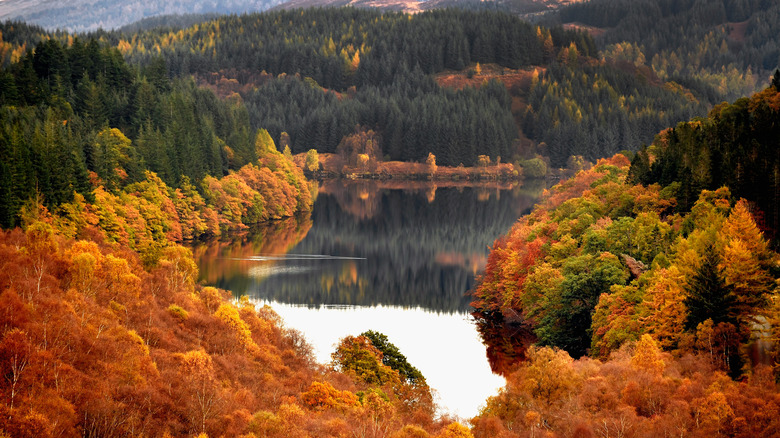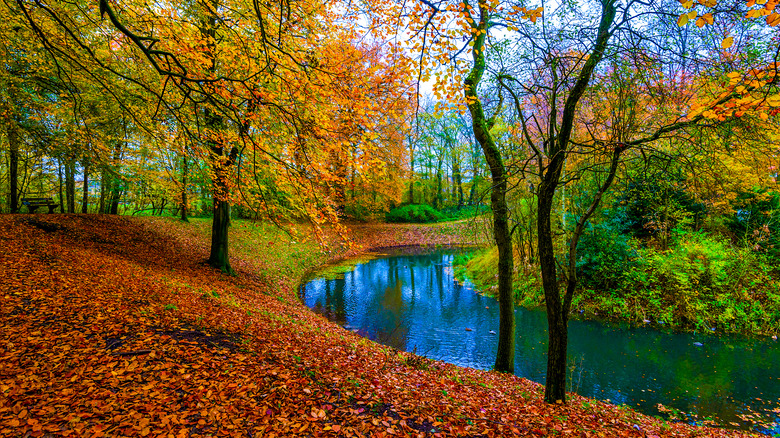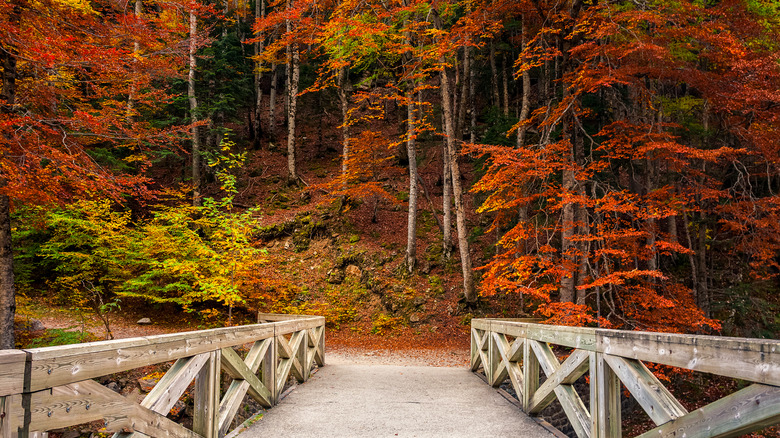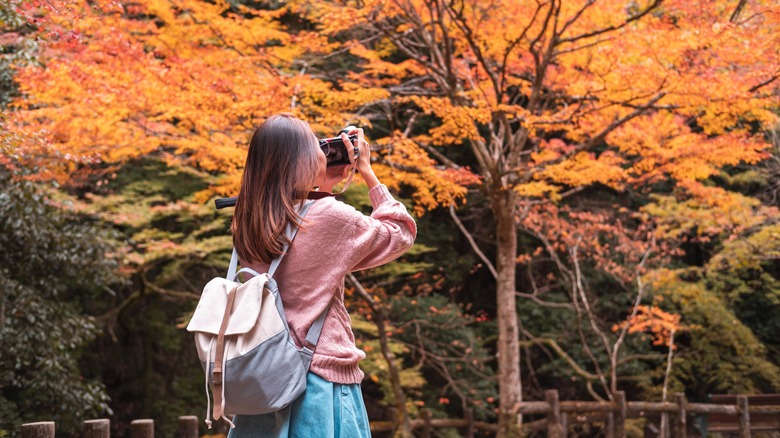How To Determine Your State's Peak Foliage Timing For All Your Fall Pics
It's hard to pinpoint exactly when fall begins; maybe it's when the air starts to get that crisp feeling to it, or maybe it's when Starbucks re–releases the PSL. "Taking my first sip of my pumpkin cream cold brew is the equivalent of iron man putting his suit on I'm so serious," tweeted one Twitter user. For many, however, the true mark of autumn comes when the leaves start to change color and fall from their branches. Many people think that cold weather is responsible for the color change in leaves, but there's more to it. Drops in both the temperature and length of daylight trigger leaves to stop producing green chlorophyll, causing the changing of the leaves' colors (via Purdue University).
The key to the best fall foliage viewing is to catch the leaves at their peak colors but before too many fall. Whether your area is already getting chilly or the temperatures are still looking warm for the next few weeks, it's never too soon to start thinking about all the fun fall activities you'd like to plan for the coming months. And experts say the shift may be getting more unpredictable. "Instead of trees doing this gradual change, they change all of a sudden, or they drop leaves early," arborist Michael Sundberg tells USA Today. "It's been a few years since we've had a really good leaf year where you just drive around town and see really good color."
When is peak foliage season and how long does it last?
The key to getting the most out of your leaf-peeping journey is timing your trip with the changing of the leaves. And although it's not an exact science, there is a tool you can use to find the ideal time to spot colors during the autumn season in your home state. Smoky Mountains' fall foliage prediction map uses factors like historical precipitation, temperatures, forecasts, and other data to give you a better idea of peak leaf-peeping time in your area. "What started as a fun side-project quickly became the most respected nationwide fall leaf map and one of the best fall resources in the country," David Angotti, the map's creator, tells Travel + Leisure.
In terms of the best time of year to plan your annual leaf viewing excursion, leaves can begin changing color as early as mid-September, and the season lasts through early November. Typically, the best time of year to see the most colorful leaf changeover happens during the second and third week of October, but it may vary depending on your state (via Almanac). In the Midwest and Northern states, most of the leaves will have started changing by late September, while New England and the Pacific Northwest experience their peak fall color closer to the middle of October. And if you find yourself in the more Southern states, the best time to go leaf peeping in your area will probably be mid–to–late October (via Smoky Mountains).
How to choose when and where to go leaf peeping
If you're not located in an area with a lot of changing seasons, you might be due for a leaf-peeping road trip. In that case, you'll want to plan the perfect getaway weekend that makes the most of both your drive up and your stay among nature. When it comes to prime fall foliage destinations, standouts include New England, Colorado, upstate New York, the Blue Ridge Parkway, and the upper Midwest (via TripSavvy). However, there are plenty of hidden gems along the way offering winding country lanes perfect for road-trippers.
And of course, you'll want to plan plenty of time to fully enjoy your fall vacation. Leaf peeping and autumn-inspired activities are among the most popular tourist attractions for some of these areas, so you can expect lots of local fun and festivities. According to The New York Times, more than 60% of Americans said they plan to travel in fall 2022, compared with 54% of respondents who said the same in 2021. So it's important to start planning for your foliage watch party sooner rather than later. From the Vermont cheese trails to hiking your way through Massachusetts to whale watching off Cape Cod, there's a lot you can pack into your next fall road trip (via Condé Nast Traveler). So, whatever your reason, be sure to give yourself a few extra days to take the road less traveled and enjoy the local sites while you're in town.
Tips for taking great fall foliage photos
Once you've found your perfect leaf-peeping location, it's time to take those Insta–worthy photos. There are a few tips you should keep in mind in order to capture the full beauty of the changing autumn leaves. For starters, you'll want to avoid bright or harsh natural light, as it can wash out the vibrant fall shades on film. "An overcast day is best — first, because you can shoot all day long, and second because the light is soft and even," nature photographer Rod Planck tells Nikon. He goes on to explain that color theory plays a huge role in nature photography and that because autumn leaves boast saturated colors, they contrast well with a gray, overcast day.
Another tip that many nature photographers suggest is getting out before the sun rises to find your ideal setup. "So much of the magic happens at dawn in the fall, you miss so much of what fall is if you get out at nine or ten in the morning and the sun is already bright," environmental scientist and nature photographer Jim Salge tells Budget Travel. Not only will this allow you to avoid the crowds, but the soft, natural hue of the sun rising will give you excellent lighting for your photos. And as for the equipment to bring along to ensure you get that perfect shot, Canon suggests packing a few lens options like a wide-angle prime lens for scenery shots and a telephoto lens for close-ups.



